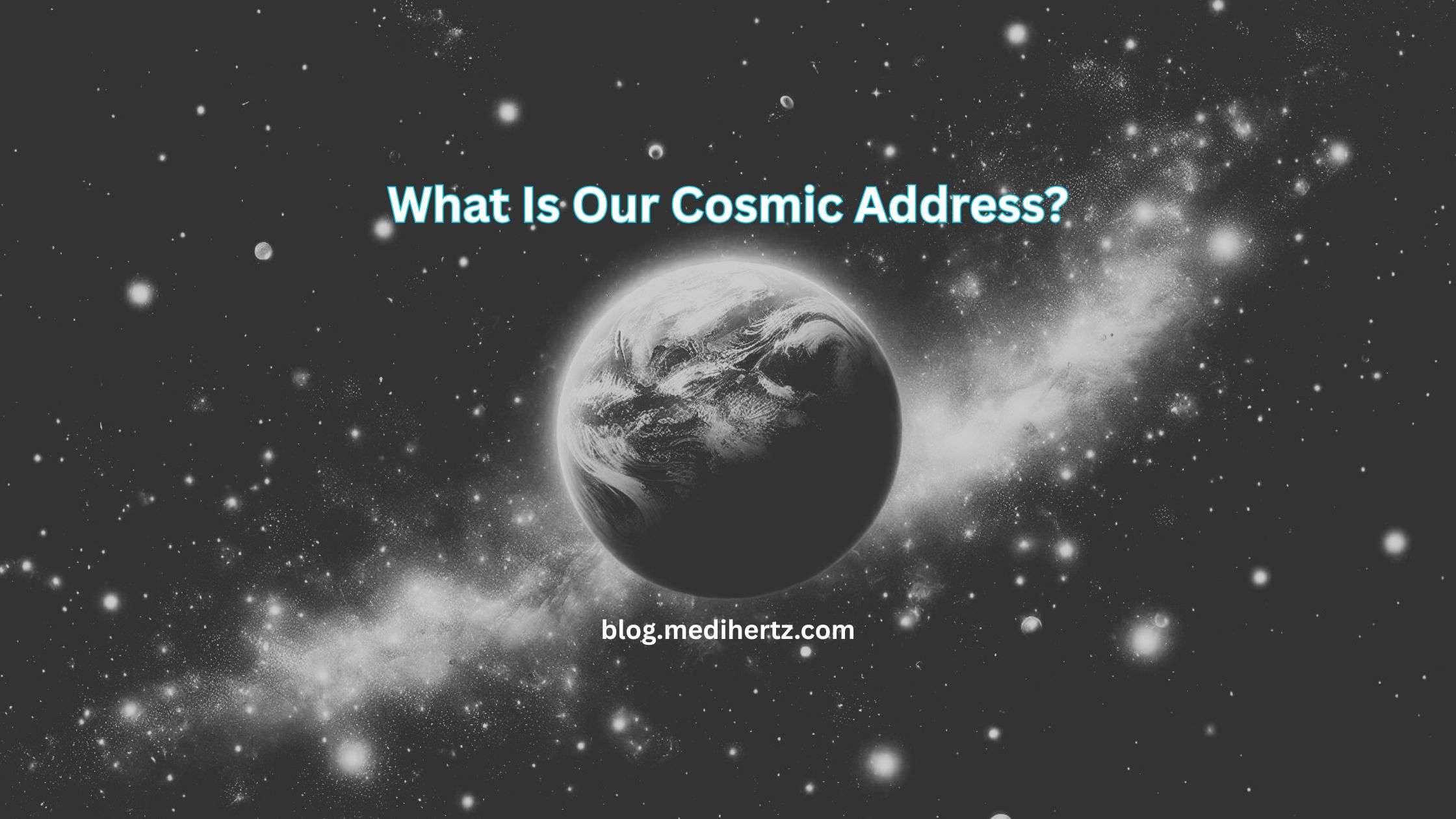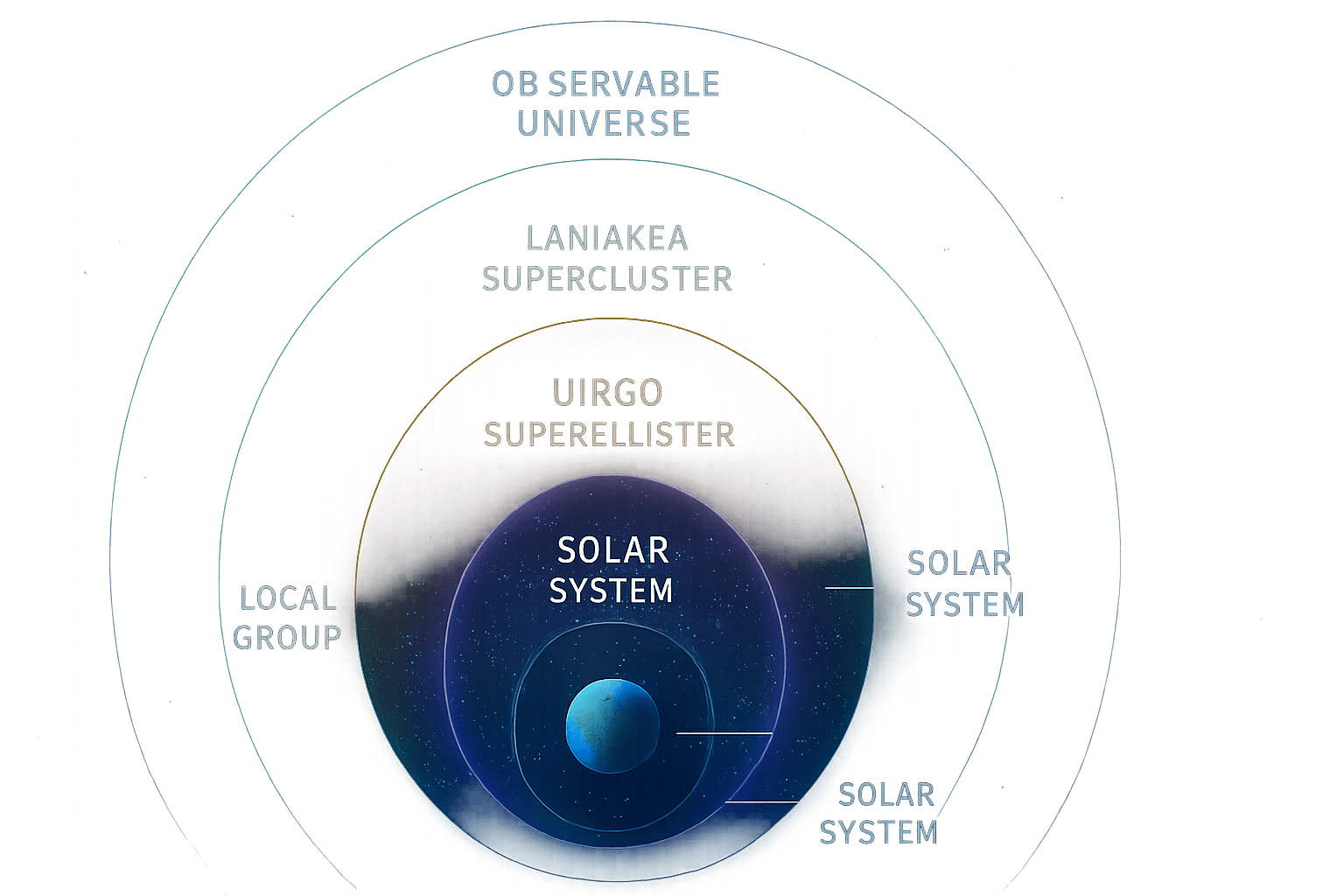What Is Our Cosmic Address? A Fun Guide to Your Place in the Universe!
Have you ever wondered, “Where exactly are we in this huge universe?” Just like your home has an address, Earth has a cosmic address—a series of “locations” that pinpoints our place in space!
Let’s break it down in the simplest (and coolest) way possible.
🌌 Our Cosmic Address (From Small to Big)
-
House/Apartment Number 🏠 – Your exact location on Earth
-
Street + City 🏙️ – Your neighborhood
-
Country 🌍 – Earth (the only known planet with life!)
-
Solar System ☀️ – The Sun and 8 planets (including Earth!)
-
Milky Way Galaxy 🌠 – Our home galaxy with 100 billion stars!
-
Local Group 🌀 – A cluster of 54 galaxies (including Andromeda!)
-
Virgo Supercluster 🪐 – A massive group of galaxy clusters
-
Laniakea Supercluster 🌐 – *Our “galactic continent” (500+ galaxies!)*
-
Observable Universe 🔭 – *Everything we can see (93 billion light-years wide!)*
Fun Fact: If the universe were a school, Earth would be a tiny speck in a classroom (Solar System), inside a school (Milky Way), in a city (Local Group), in a country (Laniakea), on a planet (Observable Universe)!
🚀 Mind-Blowing Facts About Our Cosmic Address
1. Earth Is a Speck of Dust in Space
-
If the Milky Way were the size of the USA, our Solar System would be a quarter on the ground!
-
The nearest star (Proxima Centauri) is 4.24 light-years away—that’s 25 trillion miles!
2. The Milky Way Is Just One of Trillions
-
There are 2 trillion galaxies in the observable universe.
-
Our galaxy is 100,000 light-years wide—if you traveled at light speed, crossing it would take 100,000 years!
3. We’re Part of a “Galactic City” (Laniakea)
-
Laniakea means “immense heaven” in Hawaiian.
-
It’s 520 million light-years wide—so big that gravity pulls galaxies toward it like a cosmic river!
4. The Universe Is Still Expanding!
-
Every second, the universe grows 3 million light-years bigger!
-
In 4 billion years, the Milky Way will crash into Andromeda (but stars won’t collide—space is too empty).
5. Aliens (If They Exist) Have Their Own Cosmic Address
-
If aliens sent us a postcard, it would need our full cosmic address to find us!
-
Scientists search for alien signals from exoplanets in the “Goldilocks Zone” (where life could exist).
🔭 How to Find Your Cosmic Address
Want to “zoom out” from Earth like Google Maps for space? Try:
-
NASA’s Eyes on the Solar System (interactive 3D map)
-
SpaceEngine (a universe simulator)
💡 Why Does This Matter?
Knowing our cosmic address reminds us:
✅ We’re tiny but special (Earth is the only known living planet!).
✅ The universe is HUGE (and we’ve barely explored any of it!).
✅ We’re all space travelers (Earth zooms through space at 67,000 mph!).
Final Thought
Next time you look at the stars, remember: you’re standing on a planet in a galaxy among billions, inside an ever-growing universe. How cool is that?
Want More Space Fun? Check Out:
📢 Share This With a Friend Who Loves Space! 🌟
People Also Ask
1. What is Earth’s full cosmic address?
Answer:
Earth’s cosmic address expands from small to vast:
-
Planet: Earth
-
Solar System: 3rd planet from the Sun
-
Galaxy: Milky Way (Orion Arm)
-
Local Group: 54 galaxies including Andromeda
-
Supercluster: Laniakea (meaning “immense heaven”)
-
Observable Universe: ~93 billion light-years wide
(Source: NASA, ESA)
2. How big is the Milky Way galaxy?
Answer:
-
Diameter: 100,000 light-years (if you traveled at light speed, crossing it would take 100,000 years!).
-
Stars: 100–400 billion.
-
Our Solar System’s Location: 27,000 light-years from the center.
(Source: Space.com)
3. Will humans ever leave the Milky Way?
Answer:
-
Not anytime soon! The nearest galaxy (Andromeda) is 2.5 million light-years away.
-
Current tech (like Voyager 1) would take 73,000 years to reach the closest star.
-
Future tech (light sails, warp drive?) might change this.
(Source: Scientific American)
4. What is the Laniakea Supercluster?
Answer:
-
A massive web of galaxies (including the Milky Way) spanning 520 million light-years.
-
Acts like a “cosmic watershed”—galaxies flow toward its center due to gravity.
-
Named from Hawaiian for “immeasurable heaven.”
(Source: Nature Journal)
5. How do we know the universe is expanding?
Answer:
-
Hubble’s Law: Distant galaxies move away faster (proven by redshift).
-
Dark Energy: A mysterious force accelerating expansion.
-
Current Expansion Rate: ~70 km/s per megaparsec.
(Source: HubbleSite)
6. Could aliens know our cosmic address?
Answer:
-
Possibly! NASA’s Voyager carries a “Golden Record” with Earth’s location.
-
SETI searches for alien signals but hasn’t found any yet.
-
Problem: Space is so vast, signals take thousands of years to reach nearby stars.
(Source: SETI Institute)
7. What’s beyond the observable universe?
Answer:
-
We don’t know! It could be:
-
Infinite space with more galaxies.
-
A “multiverse” of other universes.
-
-
Limit: We can’t see beyond 93 billion light-years (light hasn’t reached us yet).
(Source: Live Science)
Related questions asked
1. What is Earth’s cosmic address?
Earth’s cosmic address is the way scientists describe where our planet sits in the universe. It goes like this:
Earth → Solar System → Milky Way Galaxy → Local Bubble → Local Group → Virgo Supercluster → Laniakea Supercluster → Observable Universe.
2. What are the six lines of our cosmic address?
The six main location lines are:
-
Earth
-
Solar System
-
Milky Way Galaxy
-
Local Group
-
Virgo Supercluster
-
Laniakea Supercluster
3. What is our location in the universe?
We live on Earth, a planet inside the Solar System, located in a spiral arm of the Milky Way Galaxy called the Orion Arm, about 25,000–27,000 light-years from the galactic center.
4. Why is 95% of the universe invisible?
Because it is made of dark matter and dark energy, which do not emit light. We cannot see them, but we know they exist from their gravity and how they affect galaxies.
5. Where is God located in the universe?
Different religions answer differently. Science does not measure God’s location. Spiritually, people believe God exists beyond physical space, not limited to one place.
6. Did NASA see heaven?
No. NASA has never claimed to see heaven. Heaven is a spiritual belief, not a physical place that telescopes can detect.
7. Why is 777 the number of God?
Many people believe 777 represents spiritual perfection or divine completeness. It is used mostly in Christian symbolism and modern spirituality.
8. Who is Universe 1 God?
There is no single “Universe 1 God” in science. Different cultures have their own beliefs about the creator or divine power of the universe.
9. Is Earth 3rd or 4th?
Earth is the 3rd planet from the Sun, after Mercury and Venus.
10. Which galaxy is our neighbor?
Our closest major galaxy neighbor is Andromeda, about 2.5 million light-years away.
11. How do I address the universe?
People often “address” the universe through personal practices like gratitude, affirmations, manifesting, or prayer. Example: “Dear Universe, guide me today.”
12. What is the zombie galaxy?
A “zombie galaxy” is a galaxy that stopped making new stars, but older stars still glow. Scientists call these “quenched galaxies.”
13. What is 25,000 light-years away?
Earth is roughly 25,000 light-years from the center of the Milky Way, where a massive black hole (Sagittarius A*) exists.
14. Can I see the Milky Way from India?
Yes, you can. You need:
✅ a dark area
✅ clear sky
✅ no city lights
Best months: February to October.
15. What is the 777 rule for manifesting?
The 777 manifesting rule means repeating an intention 7 times in the morning, 7 times in the afternoon, and 7 times at night to focus your energy.
16. What are the 7 spiritual needs?
The commonly known needs are:
-
Peace
-
Purpose
-
Connection
-
Healing
-
Identity
-
Gratitude
-
Hope
17. How to pray to the universe?
You can pray with gratitude and intention. Example:
“Universe, thank you for guiding me. Help me move toward my purpose today.”
It is a personal belief-based practice, not a religious requirement.
The 3i Atlas Mystery: Ancient and Modern Predictions
What Is Walmart’s DEI Program? (Diversity, Equity & Inclusion Explained)
3I/ATLAS: Is the Interstellar Object Alien Technology?
Mystery From the Sky: The Buga Sphere Appears in Colombia
Oumuamua: The Mysterious Interstellar Visitor and the Cosmic Message in Prashyant Jha’s Song
Hz Frequency Generator- Free Online Tone Generator
Also Read- 👉
👉What is 7 Hz good for? A careful, evidence-based guide (with references)
👉Cymatics: From 2D Sand Patterns to 3D Sound Sculptures
👉 Hz Frequency Generator- Free Online Tone Generator
👉 What Frequencies Are Dangerous to Humans? Understanding Risks from Sound to Radiation
👉How to do a Cymatic Experiment
👉What is the science behind cymatics?
👉 NASA-Approved 30-Min Brain Boost
👉 What Is The Healing Power Of Sound Wave
👉 What does 528 hz do to the brain?
👉 The 7 Healing Frequencies: Unlocking the Power of Sound for Wellness
👉 The Sacred Science of Yantras: How Cymatics Validates Ancient Tantric Geometry
👉 Is 1111 a Lucky Number? A Deep Dive into Its Mystical, Numerological, and Cultural Significance
People Also Read
- 2030 A Doomsday According to Indian Texts or Misinterpretation?
- The Glory of Narasimha Bhagwan: An Exploration of Ancient Indian History
- Medusa and Mansa Devi: The Untold Myths Connecting Greek and Hindu Traditions
- “The Enigmatic Link Between the Bermuda Triangle and Hindu Mythology of Ramayan: Unveiling the Mystery”
- why is mt. Kailash Considered to be a Sacred Site?
- How Eastern Wisdom Can Transform Your Modern Life.
- Lord Shani and Lord Yam : God of Karma for Living and Death
- In which direction Ganesh Idol should face.
- What is the logic for existence of God?
- Who Is Mahadev Shiv ?
- How to increase love for Krishna?
- Hanuman Chalisa English Lyrics| Bhajle Ram Naam | Prashyant Jha
Free AI Tools To test yourself
- Love Percentage Checker Tool – Check For Free!
- Soulmates Initial Finder
- Hz Frequency Generator- Free Online Tone Generator
- Mental Health Check In Tool [ FREE TEST ]
- Best Free Phone Photos Download
- Image Converter (Online & Free)
Seotoolrank.com Free Ai Tools
- RankVortex – Implies pulling traffic and SEO rankings toward you.
- How do I convert a PNG file to BMP?
- ConvertEase PDF
- Website Speed Checker Tool
- SEO Word Counter with Character Count
- Free Stopwatch and Online Timer Countdown
- Age Calculator Tool
- Password Generator Tool
- Qr Code Generator Free
- AI Story Generator Tool
- Blog Title Generator Tool [FREE]





